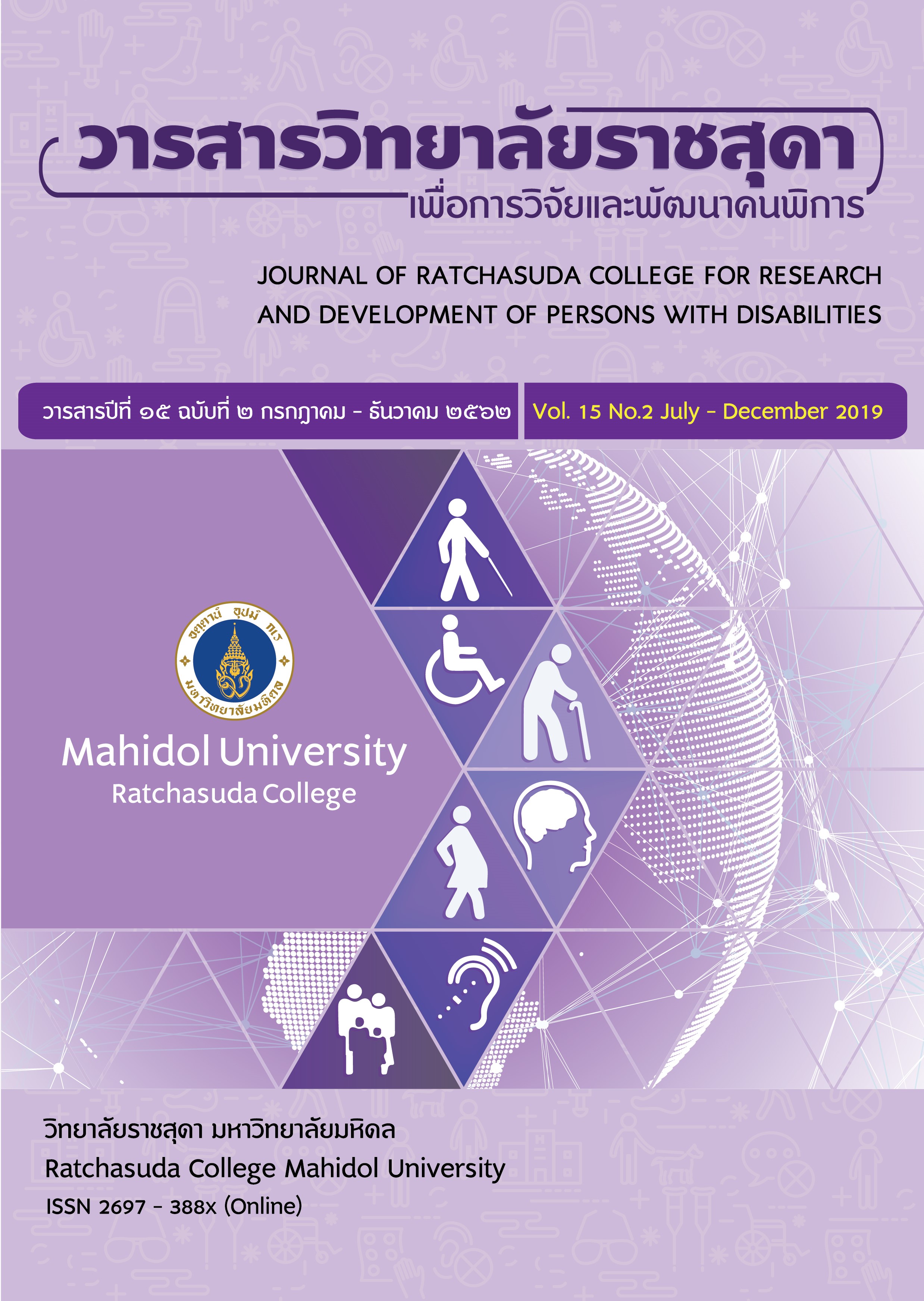Investigating the Effect of Music Therapy on Speech Rehabilitation Hard of Hearing Young Adults
Keywords:
Music Therapy, Speech, Hard of Hearing young AdultsAbstract
The purpose of this study was to investigate the effectiveness of music therapy on speech rehabilitation in hard of hearing young adults. Repeated-measures experimental and qualitative research designs were employed to examine the effectiveness of music therapy. Participants The purpose of this study was to investigate the effectiveness of music therapy on speech rehabilitation in hard of hearing young adults. Repeated-measures experimental and qualitative research designs were employed to examine the effectiveness of music therapy. Participants were nine hard-of-hearing undergraduate students from Ratchasuda College, Mahidol University. The experiment consisted of 10 sessions, twice a week, and an one hour long per session. Music interventions included aural training, vocal warm up, and singing. Hard of Hearing’ Speech Test Manual, interview, and observational protocols were used as research instruments to collect and measure the data. For the data analysis, repeated-measures ANOVA was used to compare the quantitative data and inductive analysis was used to analyze the qualitative data. The research concluded that music therapy can enhance speech rehabilitation in hard of hearing young adults. Although, eventual scores for overall vocalization were no statistically different at .05 level of significance, 8 out of 9 indicator scores on each test were all increased, especially on Vocalizations are of clear tonal quality and Vocalizations are of appropriate volume both indicators are statistically different at .05
Downloads
References
American Music Therapy Association. (2016). What is music therapy?. Retrieved October 23, 2016, from www.musictherapy.org/.
Assanasan, P. (2014). Hearing Problems in Elderly. Retrieved on September 1st, 2016 from http://rcot.o rg/ 2016/People/Detail/191
Baxter, H. T., Berghofer, J. A., MacEwan, L., Nelson, J., Peters, K., & Roberts, P.(2007). The Individualized Music Therapy Assessment Profile. Lodon, NI: Jessica Kingsley Publishers.
Chiengchana, N. (2016). Music for hearing impaired: An assessment to the need in deaf schools. Research journal and Special education development. 5(1), pp. 23-39.
Choksy, L. (2000). The kodaly method I: Comprehensive music education [3th Edition]. Upper Saddle River, NJ.
Chumwichan, S. (2012). The development of learning outcomes and musical attitudes from deaf children using music activities to develop rhythmic abilities. Master of Education in Music Education. Bangkok: Chulalongkorn University.
Darrow, A. A. & Cohen, N. (1991). The effect of programmed pitch practice and private instruction on the vocal reproduction accuracy of children with hearing impairments: Two case studies. Music Therapy Perspectives. 9(4). 61-65
Darrow, A. A., Gfeller, K., Gorsuch, A., & Thomas, K. (2000). Music therapy with children who are deaf and hard-of hearing. In C.E. Furman (Ed.). Effectiveness of music therapy procedures: Documentation of research and clinical practice (3rd ed., pp. 135-136). Silver Spring, MD: Americ an Music Therapy Association.
Darrow, A. A., & Starmer. G. J. (1986). The effect of vocal training on the intonation and rate of hearing impaired children’s speech. Journal of music therapy, 23(4), 194-201
Davis, W. B., Gfeller, K. E., & Thaut, M. (2008). An introduction to music therapy: Theory and practice. MD: American Music Therapy Association.
Gfeller, K., Driscoll, V., Kenworthy, M., & Voorst, T. V. (2011). Music therapy for preschool cochlear implant recipients. Music Therapy Perspectives. 29(4). 39-49.
Gfeller, K., Guthe, E., Driscoll, V., & Brown, C. J. (2015). A preliminary report of music-based training for adult cochlear implant users: Rationales and development. Cochlear Implants International, 16(3), 22-31.
Goldman, R. (2011). Goldman fristoe-2: Research administration and interpretation. Retrieved March 9 2016, Retrieved from http://images.pearsonassessments.com /images/PDF/GFTA-2.pdf.
Kosaner, J., Kilinc, A., & Deniz, M. (2012). Developing a music programme for preschool children with cochlear implants. Cochlear Implants International. 13(4). 237-247
Ministry Of Education Announcement. (2009). Education provision for persons with disabilities act. [Date file]. From www.mua.go.th/users/he-commission/doc/law/ ministry %20law/1-42%20handicap%20MoE.pdf
Ministry of Social Development and Human Security. (2009). Classification and types of persons with disabilities. [Data file]. Retrieved from http://www.person.ku.ac.th/new_perso nweb/
per_6/per_6_4/ per_6_4-6.pdf
Packer, L. (2015). Hearing loss in adulthood. Retrieved October 20, 2017 from https://www. healthy hearing.com/report/52506-Hearing-loss-in-adulthood.
Prathanee, B. (1995). Aphasia. Khonkaem: Department of Otolaryngology. Faculty of Medicine, Khonkaen University.
Robbins, A., & Robbins, C. (1980). Music for the hearing impaired. US: Magnamusic-Baton.
Stegemöller, E. L., Hurt, T. R., O’Connor, M. C., Camp, R. D., Green, C. W., Pattee, J. C., & Williams, E. K. (2017). Experiences of persons with Parkinson’s Disease engaged in group therapeutic singing. Journal of Music Therapy. 00(00), 1-27.
Staum, M. J. (1987). Music notation to improve the speech prosody of hearing impaired children.Journal of music therapy. 24(3), 146-159.
Tantranon, R. (2008). Evangelism: Academic articles on speech impaired. Bangkok: Otolaryngology Clinic in Department of Otolaryngology, Faculty of Medicine Ramathibodi Hospital, Mahidol University.
World Health Organization. (2015). Who global estimates on prevalence of hearing loss. Retrieved October 2, 2017 from www.who.int/pbd/deafness/WHO_ GE_HL.pdf
Downloads
Published
How to Cite
Issue
Section
License
บทความที่ได้รับการตีพิมพ์เป็นลิขสิทธิ์ของวารสารสถาบันราชสุดาเพื่อการวิจัยและพัฒนาคนพิการ






